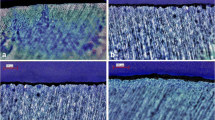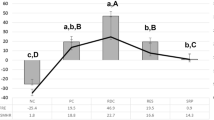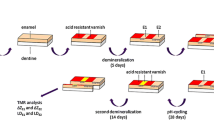Abstract
Objectives
The aim of this in vitro study was to compare the caries-preventive effect of various high fluoride- and calcium-containing caries-preventive agents (> 22.000 ppm F− [ppm]) in adjunct to use of regular (1450 ppm) or high (5000 ppm) fluoride toothpaste on sound as well as demineralized enamel.
Materials and methods
Bovine enamel specimens (n = 276; 5 mm × 3.5 mm × 3 mm) having one sound surface [ST] and one artificial caries lesion [DT] were randomly allocated to 12 groups. Interventions before pH-cycling were no intervention ([SC1/SC5]), application of varnishes/solutions containing NaF (22,600 ppm; Duraphat [NaF1/NaF5]); NaF + tricalcium phosphate (22,600 ppm; Clinpro White Varnish [TCP1/TCP5]); NaF + CPP-ACP (22,600 ppm; MI Varnish [CPP1/CPP5]); silver diammine fluoride (35,400 ppm; Cariestop 30%[SDF1/SDF5]); and NaF + calcium fluoride (45,200 ppm; Biophat[CaF1/CaF5]). During pH-cycling (28 days, 6 × 120 min demineralization/day) half of the specimens in each group were brushed (10 s; 2 × /day) with either 1,450 (NaF; named, e.g., TCP1) or 5,000 ppm (NaF; e.g., TCP5) dentifrice slurry. Differences in integrated mineral loss (∆∆Z) and lesion depth (∆LD) were calculated between values after initial demineralization and after pH-cycling using transversal microradiography.
Results
After pH-cycling, SC1/SC5 showed significantly increased ∆ZDT/LDDT values, indicating further demineralization (p < 0.05; paired t-test). Decreased ∆ZDT values, indicating non-significant remineralization, could only be observed in CaF1/CaF5 (p > 0.05; paired t-test). Additional use of all varnishes/solutions significantly decreased ∆∆ZDT/∆∆ZST and ∆LDDT/∆LDST compared to SC1/SC5 (p < 0.05;ANCOVA). Between 1450 and 5000 ppm dentifrices, a significant difference in ∆∆ZDT/∆∆ZST and ∆LDDT/∆LDST could only be observed for SC1/SC5 (p < 0.05; ANCOVA).
Conclusion
Under the conditions chosen, all fluoride varnishes/solutions significantly reduced demineralization. Furthermore, a significant dose–response characteristic for fluoride varnishes could be revealed. However, no additional benefit could be observed, when varnishes were combined with high fluoride instead of regular fluoride dentifrices.
Clinical relevance
For children and adolescents with high caries risks varnishes containing more than 22,600 ppm should be further investigated, as they offered higher caries-preventive effects in vitro. Furthermore, there seems to be no difference in the demineralization-inhibitory capacity of fluoride varnishes when used in combination with either standard or highly fluoridated dentifrices.



Similar content being viewed by others
Data availability
All data generated or analyzed during this study are included in this article [and/or] its supplementary material files. Further enquiries can be directed to the corresponding author.
References
Pessan JP, Toumba KJ, Buzalaf MAR (2011) Topical use of fluorides for caries control. Monogr Oral Sci 22:115–132. https://doi.org/10.1159/000325154
Ogard B, Seppa L, Rolla G (1994) Professional topical fluoride applications–clinical efficacy and mechanism of action. Adv Dent Res 8:190–201. https://doi.org/10.1177/08959374940080021001
Marinho VC, Worthington HV, Walsh T and Clarkson JE (2013) Fluoride varnishes for preventing dental caries in children and adolescents. Cochrane Database Syst Rev:CD002279. https://doi.org/10.1002/14651858.CD002279.pub2
Karlinsey RL, Mackey AC, Walker TJ, Frederick KE, Blanken DD, Flaig SM, Walker ER (2011) In vitro remineralization of human and bovine white-spot enamel lesions by NaF dentifrices: a pilot study. J Dent Oral Hyg 3:22–29
Mohd Said SN, Ekambaram M, Yiu CK (2017) Effect of different fluoride varnishes on remineralization of artificial enamel carious lesions. Int J Paediatr Dent 27:163–173. https://doi.org/10.1111/ipd.12243
Reynolds EC (1997) Remineralization of enamel subsurface lesions by casein phosphopeptide-stabilized calcium phosphate solutions. J Dent Res 76:1587–95. https://doi.org/10.1177/00220345970760091101
Attin T, Hartmann O, Hilgers RD, Hellwig E (1995) Fluoride retention of incipient enamel lesions after treatment with a calcium fluoride varnish in vivo. Arch Oral Biol 40:169–74. https://doi.org/10.1016/0003-9969(95)98804-8
Erdwey D, Meyer-Lueckel H, Esteves-Oliveira M, Apel C, Wierichs RJ (2021) Demineralization Inhibitory effects of highly concentrated fluoride dentifrice and fluoride gels/solutions on sound dentin and artificial dentin caries lesions in vitro. Caries Res 55:41–54. https://doi.org/10.1159/000509931
Rosenblatt A, Stamford TC, Niederman R (2009) Silver diamine fluoride: a caries “silver-fluoride bullet.” J Dent Res 88:116–25. https://doi.org/10.1177/0022034508329406
Delbem AC, Bergamaschi M, Sassaki KT, Cunha RF (2006) Effect of fluoridated varnish and silver diamine fluoride solution on enamel demineralization: pH-cycling study. J Appl Oral Sci 14:88–92. https://doi.org/10.1590/s1678-77572006000200005
Yu OY, Mei ML, Zhao IS, Li QL, Lo EC, Chu CH (2018) Remineralisation of enamel with silver diamine fluoride and sodium fluoride. Dent Mater 34:e344–e352. https://doi.org/10.1016/j.dental.2018.10.007
Wierichs RJ, Stausberg S, Lausch J, Meyer-Lueckel H, Esteves-Oliveira M (2018) Caries-Preventive Effect of NaF, NaF plus TCP, NaF plus CPP-ACP, and SDF varnishes on sound dentin and artificial dentin caries in vitro. Caries Res 52:199–211. https://doi.org/10.1159/000484483
Pithon MM, Dos Santos MJ, Andrade CS, Leao Filho JC, Braz AK, de Araujo RE, Tanaka OM, Fidalgo TK, Dos Santos AM, Maia LC (2015) Effectiveness of varnish with CPP-ACP in prevention of caries lesions around orthodontic brackets: an OCT evaluation. Eur J Orthod 37:177–82. https://doi.org/10.1093/ejo/cju031
Gluzman R, Katz RV, Frey BJ, McGowan R (2013) Prevention of root caries: a literature review of primary and secondary preventive agents. Spec Care Dentist 33:133–40. https://doi.org/10.1111/j.1754-4505.2012.00318.x
Twetman S, Keller MK (2016) Fluoride rinses, gels and foams: an update of controlled clinical trials. Caries Res 50(Suppl 1):38–44. https://doi.org/10.1159/000439180
Central German Ethics Committee (2003) The use of human body materials for the purpose of medical research (in German). https://www.zentrale-ethikkommission.de/stellungnahmen/koerpermaterialien/. Accessed 21 Nov 2021
Meyer-Lueckel H, Wierichs RJ, Gninka B, Heldmann P, Dorfer CE, Paris S (2015) The effect of various model parameters on enamel caries lesions in a dose-response model in situ. J Dent 43:1261–7. https://doi.org/10.1016/j.jdent.2015.08.003
Buskes JA, Christoffersen J, Arends J (1985) Lesion formation and lesion remineralization in enamel under constant composition conditions. A new technique with applications. Caries Res 19:490–6. https://doi.org/10.1159/000260887
Wierichs RJ, Kogel J, Lausch J, Esteves-Oliveira M, Meyer-Lueckel H (2017) Effects of self-assembling peptide P11–4, fluorides, and caries infiltration on artificial enamel caries lesions in vitro. Caries Res 51:451–459. https://doi.org/10.1159/000477215
Jansen EE, Meyer-Lueckel H, Esteves-Oliveira M, Wierichs RJ (2021) Do bleaching gels affect the stability of the masking and caries-arresting effects of caries infiltration-in vitro. Clin Oral Investig 25:4011–4021. https://doi.org/10.1007/s00784-020-03732-4
Wierichs RJ, Rupp K, Meyer-Lueckel H, Apel C, Esteves-Oliveira M (2020) Effects of dentifrices differing in fluoride content on remineralization characteristics of dentin in vitro. Caries Res 54:75–86. https://doi.org/10.1159/000504165
Esteves-Oliveira M, Santos NM, Meyer-Lueckel H, Wierichs RJ, Rodrigues JA (2017) Caries-preventive effect of anti-erosive and nano-hydroxyapatite-containing toothpastes in vitro. Clin Oral Investig 21:291–300. https://doi.org/10.1007/s00784-016-1789-0
Angmar B, Carlstrom D, Glas JE (1963) Studies on the ultrastructure of dental enamel. IV. The mineralization of normal human enamel. J Ultrastruct Res 8:12–23. https://doi.org/10.1016/s0022-5320(63)80017-9
de Josselin de Jong E, ten Bosch JJ and Noordmans J, (1987) Optimised microcomputer-guided quantitative microradiography on dental mineralised tissue slices. Phys Med Biol 32:887–99. https://doi.org/10.1088/0031-9155/32/7/008
Arends J, Dijkman T, Christoffersen J (1987) Average mineral loss in dental enamel during demineralization. Caries Res 21:249–54. https://doi.org/10.1159/000261028
Theuns HM, van Dijk JW, Driessens FC, Groeneveld A (1984) The surface layer during artificial carious lesion formation. Caries Res 18:97–102. https://doi.org/10.1159/000260756
Magalhaes AC, Moron BM, Comar LP, Wiegand A, Buchalla W, Buzalaf MA (2009) Comparison of cross-sectional hardness and transverse microradiography of artificial carious enamel lesions induced by different demineralising solutions and gels. Caries Res 43:474–83. https://doi.org/10.1159/000264685
Marinho VC, Higgins JP, Logan S and Sheiham A (2003) Topical fluoride (toothpastes, mouthrinses, gels or varnishes) for preventing dental caries in children and adolescents. Cochrane Database Syst Rev:CD002782. https://doi.org/10.1002/14651858.CD002782
Wierichs RJ, Musiol J, Erdwey D, Esteves-Oliveira M, Apel C, Meyer-Lueckel H (2020) Re- and demineralization characteristics of dentin depending on fluoride application and baseline characteristics in situ. J Dent 94:103305. https://doi.org/10.1016/j.jdent.2020.103305
Akabane S, Delbem AC, Pessan J, Garcia L, Emerenciano N, Goncalves DF, Danelon M (2018) In situ effect of the combination of fluoridated toothpaste and fluoridated gel containing sodium trimetaphosphate on enamel demineralization. J Dent 68:59–65. https://doi.org/10.1016/j.jdent.2017.10.013
PaesLeme AF, Dalcico R, Tabchoury CP, Del BelCury AA, Rosalen PL, Cury JA (2004) In situ effect of frequent sucrose exposure on enamel demineralization and on plaque composition after APF application and F dentifrice use. J Dent Res 83:71–5. https://doi.org/10.1177/154405910408300114
Fernandez CE, Tenuta LMA, Del BelCury AA, Nobrega DF, Cury JA (2017) Effect of 5,000 ppm fluoride dentifrice or 1,100 ppm fluoride dentifrice combined with acidulated phosphate fluoride on caries lesion inhibition and repair. Caries Res 51:179–187. https://doi.org/10.1159/000453624
Wierichs RJ, Westphal S, Lausch J, Meyer-Lueckel H, Esteves-Oliveira M (2018) Influence of highly concentrated fluoride dentifrices on remineralization characteristics of enamel in vitro. Clin Oral Investig 22:2325–2334. https://doi.org/10.1007/s00784-018-2333-1
Manarelli MM, Delbem AC, Lima TM, Castilho FC, Pessan JP (2014) In vitro remineralizing effect of fluoride varnishes containing sodium trimetaphosphate. Caries Res 48:299–305. https://doi.org/10.1159/000356308
Arends J, Christoffersen J (1986) The nature of early caries lesions in enamel. J Dent Res 65:2–11
Edmunds DH, Whittaker DK, Green RM (1988) Suitability of human, bovine, equine, and ovine tooth enamel for studies of artificial bacterial carious lesions. Caries research 22:327–36
Featherstone JD, Mellberg JR (1981) Relative rates of progress of artificial carious lesions in bovine, ovine and human enamel. Caries Res 15:109–14
Mellberg JR (1992) Hard-tissue substrates for evaluation of cariogenic and anti-cariogenic activity in situ. Journal of dental research 71(Spec):913–9
Magalhaes AC, Levy FM, Rios D, Buzalaf MA (2010) Effect of a single application of TiF(4) and NaF varnishes and solutions on dentin erosion in vitro. J Dent 38:153–7. https://doi.org/10.1016/j.jdent.2009.09.015
Ganss C, Schlueter N, Preiss S, Klimek J (2009) Tooth brushing habits in uninstructed adults–frequency, technique, duration and force. Clin Oral Investig 13:203–8. https://doi.org/10.1007/s00784-008-0230-8
Aykut-Yetkiner A, Attin T, Wiegand A (2014) Prevention of dentine erosion by brushing with anti-erosive toothpastes. J Dent 42:856–61. https://doi.org/10.1016/j.jdent.2014.03.011
Acknowledgements
This study was conducted as part of the doctoral thesis of J.M. We would like to thank the technical assistance of Mr. Michael Stiebritz for the preparation of the TMR-micrographs.
Funding
This study was funded by the authors and their institution.
Author information
Authors and Affiliations
Contributions
R.J.W., M.E.-O., and J.M. designed and planned the study; J.M. prepared the samples; R.J.W. and J.M. performed the measurements and statistical analysis; R.J.W. wrote the manuscript; T.G.W. and H.M.-L. commented on, and all authors revised the manuscript.
Corresponding author
Ethics declarations
Conflict of interest
The authors declare no competing interests.
Ethical approval
The study protocol conformed to the principles outlined in the German Ethics Committee’s statement for the use of human body material in medical research [16]. This study is reported according to the COPE guidelines.
Informed consent
For this type of study, formal consent is not required.
Additional information
Publisher's note
Springer Nature remains neutral with regard to jurisdictional claims in published maps and institutional affiliations.
Supplementary Information
Below is the link to the electronic supplementary material.
Rights and permissions
About this article
Cite this article
Wierichs, R.J., Mester, J., Wolf, T.G. et al. Effects of the association of high fluoride- and calcium-containing caries-preventive agents with regular or high fluoride toothpaste on enamel: an in vitro study. Clin Oral Invest 26, 3167–3178 (2022). https://doi.org/10.1007/s00784-021-04299-4
Received:
Accepted:
Published:
Issue Date:
DOI: https://doi.org/10.1007/s00784-021-04299-4




